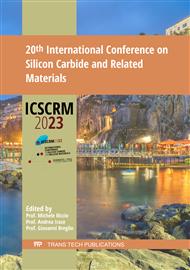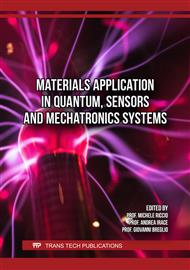[1]
L. Jia, W. Zheng, F. Huang, Vacuum-ultraviolet photodetectors, PhotoniX 1 (2020).
Google Scholar
[2]
K. Wilhelm, E. Marsch, B.N. Dwivedi, U. Feldman, Observations of the Sun at Vacuum-Ultraviolet Wavelengths from Space. Part II: Results and Interpretations, Space Sci Rev 133 (2007) 103–179.
DOI: 10.1007/s11214-007-9285-0
Google Scholar
[3]
B. Eliasson, U. Kogelschatz, UV excimer radiation from dielectric-barrier discharges, Appl. Phys. B 46 (1988) 299–303.
DOI: 10.1007/bf00686452
Google Scholar
[4]
T. Kimoto, J.A. Cooper, Fundamentals of silicon carbide technology: Growth, characterization, devices and applications, Wiley, Singapore, 2014.
DOI: 10.1002/9781118313534
Google Scholar
[5]
A. Gottwald, U. Kroth, E. Kalinina, V. Zabrodskii, Optical properties of a Cr/4H-SiC photodetector in the spectral range from ultraviolet to extreme ultraviolet, Applied optics 57 (2018) 8431–8436.
DOI: 10.1364/ao.57.008431
Google Scholar
[6]
J. Hu, X. Xin, J.H. Zhao, F. Yan, B. Guan, J. Seely, B. Kjornrattanawanich, Highly sensitive visible-blind extreme ultraviolet Ni/4H-SiC Schottky photodiodes with large detection area, Optics letters 31 (2006) 1591–1593.
DOI: 10.1364/ol.31.001591
Google Scholar
[7]
N.G. Wright, A.B. Horsfall, SiC sensors: a review, J. Phys. D: Appl. Phys. 40 (2007) 6345–6354.
DOI: 10.1088/0022-3727/40/20/s17
Google Scholar
[8]
M. Schraml, N. Papathanasiou, A. May, T. Weiss, T. Erlbacher, Towards Sic-Based VUV Pin-Photodiodes - Investigations on 4H-SiC Photodiodes with Shallow Implanted Al Emitters, KEM 947 (2023) 77–82.
DOI: 10.4028/p-959z1t
Google Scholar
[9]
Synopsys Inc., Sentaurus™ Process: Version U-2022.12, 2022.
Google Scholar
[10]
Synopsys Inc., Sentaurus™ Device: Version U-2022.12, 2022.
Google Scholar
[11]
A. Burenkov, C.D. Matthus, T. Erlbacher, Optimization of 4H-SiC UV Photodiode Performance Using Numerical Process and Device Simulation, IEEE Sensors J. 16 (2016) 4246–4252.
DOI: 10.1109/jsen.2016.2539598
Google Scholar
[12]
Synopsys Inc., Sentaurus™ Structure Editor: Version U-2022.12, 2022.
Google Scholar
[13]
O.P.A. Lindquist, K. Järrendahl, S. Peters, J.T. Zettler, C. Cobet, N. Esser, D.E. Aspnes, A. Henry, N.V. Edwards, Ordinary and extraordinary dielectric functions of 4H– and 6H–SiC from 3.5 to 9.0 eV, Appl. Phys. Lett. 78 (2001) 2715–2717.
DOI: 10.1063/1.1369617
Google Scholar
[14]
J. Weiße, M. Hauck, T. Sledziewski, M. Tschiesche, M. Krieger, A.J. Bauer, H. Mitlehner, L. Frey, T. Erlbacher, Analysis of Compensation Effects in Aluminum-Implanted 4H-SiC Devices, MSF 924 (2018) 184–187.
DOI: 10.4028/www.scientific.net/msf.924.184
Google Scholar
[15]
Y.-x. Yuan, Recent advances in trust region algorithms, Math. Program. 151 (2015) 249–281.
Google Scholar
[16]
Synopsys Inc., Sentaurus™ Workbench Optimization Framework: Version U-2022.12, (2022)
Google Scholar



